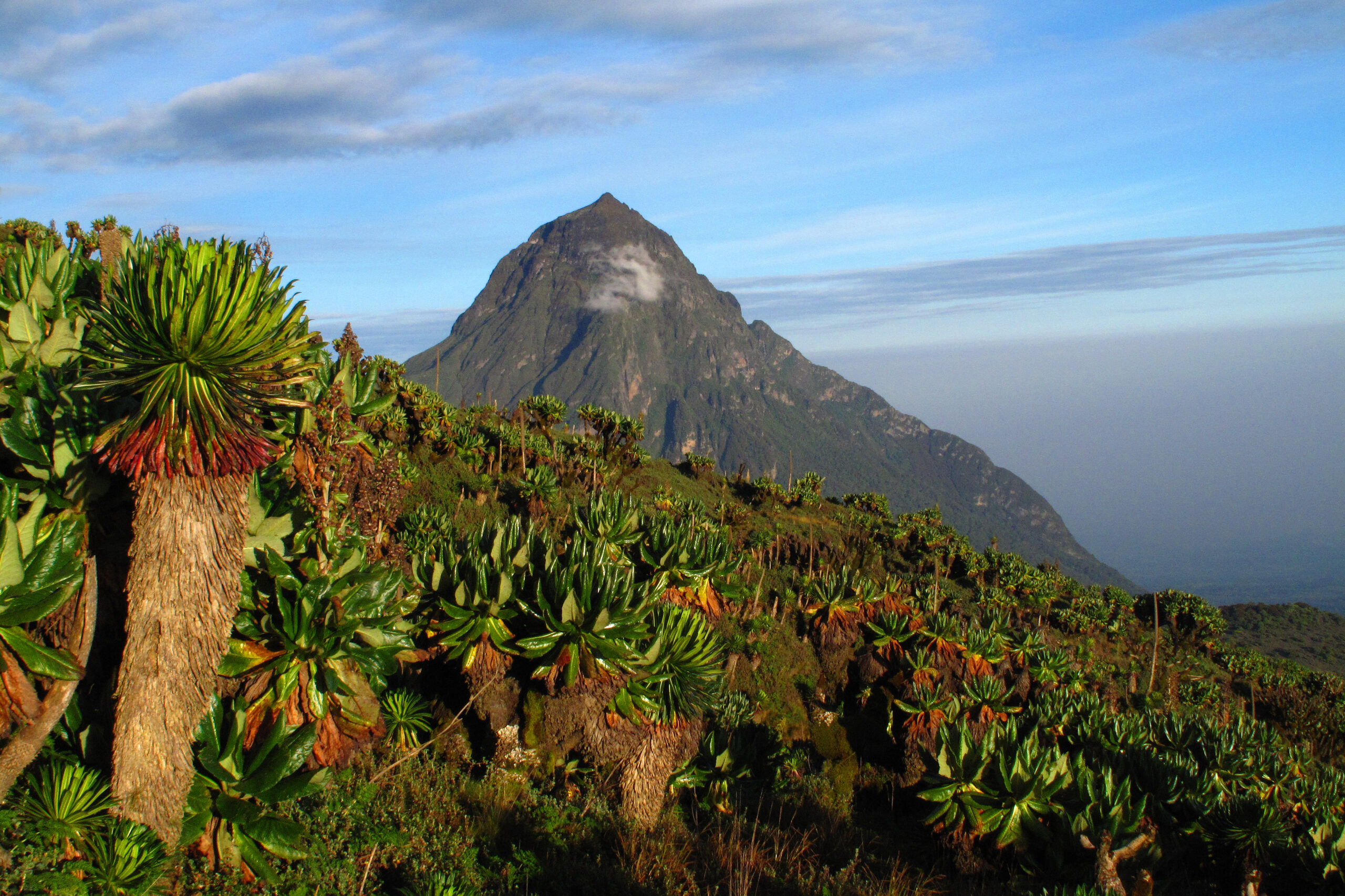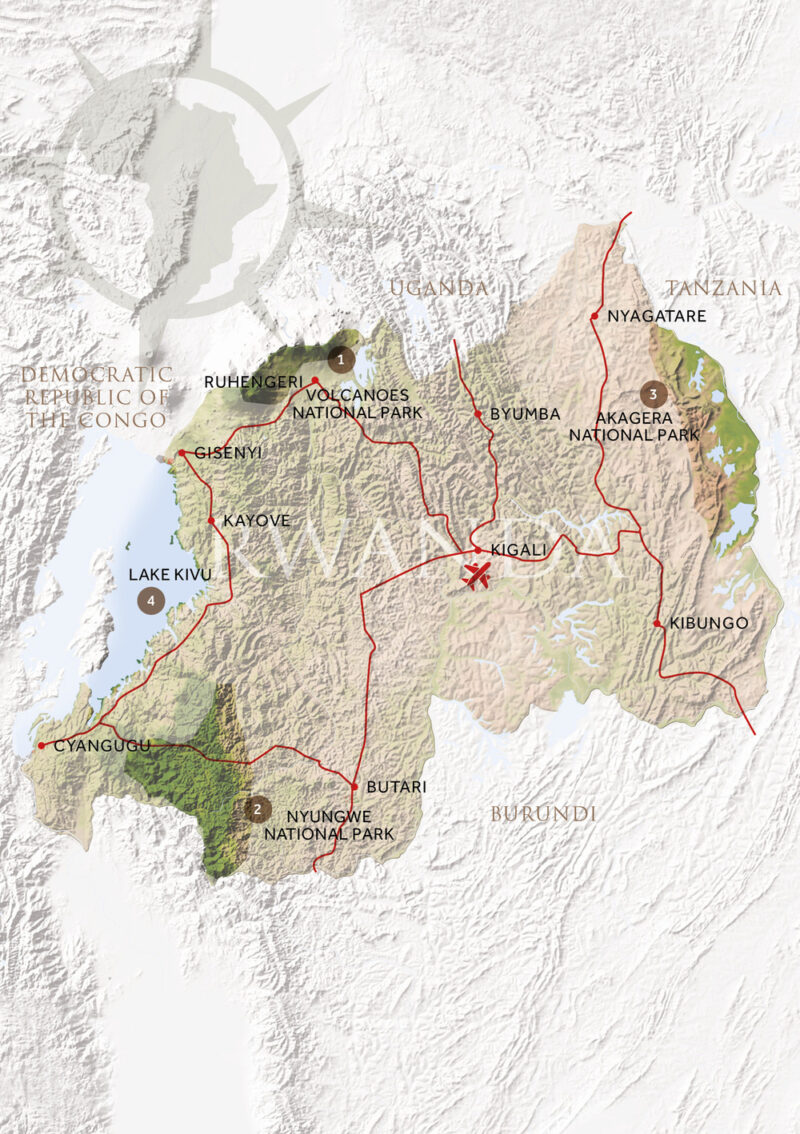
Rwanda
Rwanda is a mountainous country with the highest land to the west, then typical African savannah to the east. The mountains are steep and dramatic while the many rivers and lakes drain into the Nile and Congo and combine to create stunning scenery and lush forest. Because of its small size it’s a great place to see gorillas, as well as many other primates.
You’ll find a useful guide to Rwanda and some of its attractions at the bottom of this page, along with a handful of sample safari journeys to inspire you. All our private safaris are tailor-made – there are many different combinations possible and we work with a multitude of camps and lodges and not just the ones shown in the sample tours. We are happy to suggest combinations using our personal knowledge and first-hand experience of these areas, but if you have a preferred lodge/camp please let us know. For price guides and further information please visit explorersagainstextinction.co.uk
Why Real Africa? We are one of the official partners of conservation charity Explorers Against Extinction which means when you book with us you are also supporting conservation.
We’re dedicated to offering you a personal service using only expert consultants with extensive first-hand knowledge and offering you financial protection through our partners for full peace of mind.
For more details and guide prices, please visit explorersagainstextinction.co.uk
Highlights of Rwanda
When To Go
You can visit Rwanda throughout the year due to its temperate tropical highland climate which means it is warm, often wet and pretty much the same most of the year.
The high elevation means it is cooler than most equatorial countries, averaging between 12 and 27 degrees. It is a little hotter in the eastern savannah region.
The spring rains arrive around February and last until June and then the autumn rains start in September and last
until December.
What To Do
The priority for most people when they visit Rwanda is to see the mountain gorillas. This has to be done on foot, trekking into Volcanoes National Park with guides and rangers, so a good level of fitness is required. In the other national parks game viewing is done in a 4×4 safari vehicle, a private vehicle if on a drive-in safari or shared vehicle if flying-in. You can find out more about the country and gorilla trekking below.
Rwanda is a very mountainous country with the highest land to the west, then typical African savannah to the east. It also has many rivers and lakes which drain into the Nile and the River Congo. The main crops in the country are coffee and tea which are exported and the rest of the country is mainly given over to subsistence farming. There are three main ethnic groups in Rwanda; the Hutu, Tutsi and Twa who are the forest based pygmies.
Tourism is a fast-growing and important part of the economy and now the country’s main source of foreign income. Rwanda along with Uganda is one of the only two countries in which tourist can visit the endangered mountain gorillas. Gorilla tracking permit prices are high in order to keep numbers down and to pay back into the community this important income stream.
Rwanda has three National Parks; Volcanoes, Akagera and Nyungwe. The naturally occurring rainforest is now mostly restricted to the three parks as the rest of the country is mainly agricultural land. Nyungwe, the largest remaining tract of forest, contains 200 species of tree as well as important rare species of flowers and plants. The Volcanoes National Park is mostly bamboo woods and moorland, with small areas of forest. Akagera is Central Africa’s largest protected wetland and comprises savannah, more similar to the classic parks of East Africa.
Akagera’s journey from destruction in the 1990s to a biodiverse and thriving park is an exceptionally inspiring one.
Following the Rwandan Civil War and the 1994 genocide, refugees returned to Rwanda. They relied on the land to survive and in the process, over a number of years, the park’s natural resources were eroded. Rhino, lion and other wildlife disappeared and long horned cattle grazed in their place. African Parks assumed management of Akagera in 2010, and, working with the Rwanda Development Board and partners, a transformation began.
An extensive law enforcement programme has significantly reduced poaching; Eastern Black rhino and lion have been re-introduced, and a solar predator-proof fence is helping to mitigate human/wildlife conflict.
Lion, leopard, elephant, rhino, buffalo, hippos, crocs, giraffe, hyaena, eland, zebra and hundreds of birds species can now be seen.
Nurturing Akagera since 2010 has seen tourism revenue increase by more than 1,150%, generating US$2.5M annual revenue and making Akagera 90% self-financing.
Nyungwe Forest boasts lots of different primate species such as chimpanzees and colobus monkeys. Here the colobus monkey colonies can be very big – even up to 400 individuals.
The most famous of the national parks is the Volcanoes which is home to an estimated one third of the remaining worldwide mountain gorilla population. There are also hundreds of different bird species in Rwanda to be found in the national parks.
Rwanda is also home to the impressive Virunga volcano range which includes the highest peak of Mount Karisimbi at 14,787 feet. The other mountains are found in the centre and western parts of Rwanda and they form part of the Great East Africa Rift which leads down through Kenya and Tanzania.
Why We Love
Rwanda, because of its size, is a great place to see gorillas – Rwanda is considered more accessible than Uganda for those wishing only to see primares. The drive to the National Park is only a few hours and the gorilla trekking well organised. Gorilla families tend to be far closer to the main headquarters and treks to see them much shorter.
If you want to see something a bit different then why not visit during their annual gorilla christening, when all new-born gorillas are given an official name.
